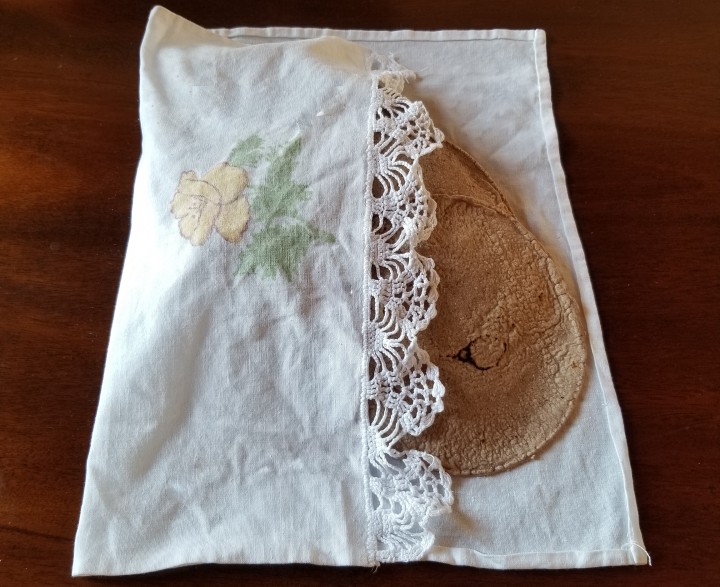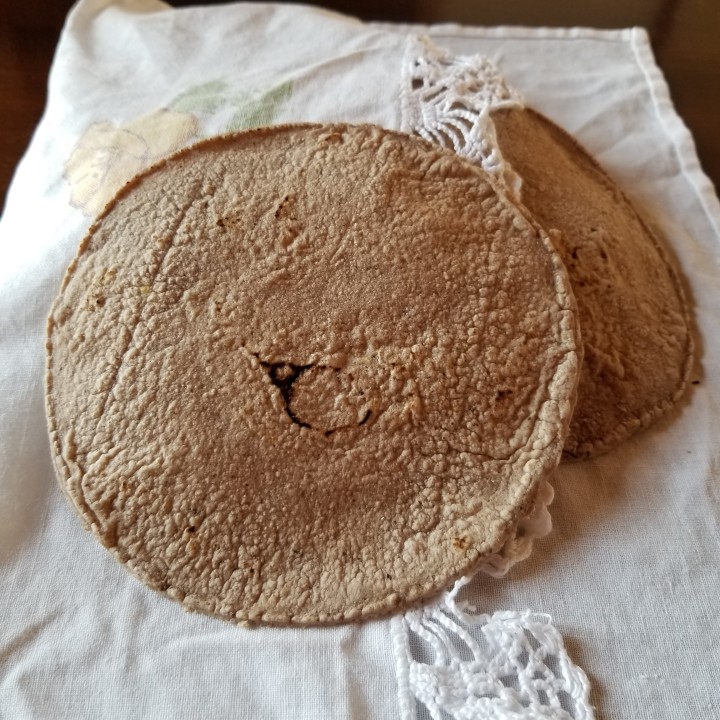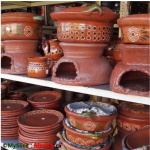
About a year ago, I posted a review of all the corn flours available in my area; I treated it as a lab experiment, including as much information about the products as I could find, but not much about the companies, to keep it basic and unbiased. Please check my post out (Corn Flour and Masa 101) for a detailed explanation on different types and names for corn flour, the process of nixtamalization (to soften dry corn, which also enhances flavour and nutritional value), and how to make corn tortillas at home. My conclusion was that from my batches, Bob’s Red Mill™ – organic, and ground from dried nixtamalized corn dough – was the best flour for corn tortillas, (photo below, left). I found that very encouraging as an option for making tortillas at home, especially since the leading Mexican brand, Maseca™, turned out to be very disappointing, as I noted in my post “… the flavour was nothing special, just like packaged tortillas.” (photo below, right):
I did not think much about it afterwards, but during my recent trip to Mexico, I learned the possible reason, and how much the tortilla market and masa (corn dough) supply have changed since I moved to Canada in the 1980s. In many urban areas in Mexico, the introduction of tortilla machines (invented in 1947) brought the convenience of producing a freshly made product at mass scale without sacrificing flavour or quality:

As a kid, it was mesmerizing to look at the whole process right before my eyes at the tortillería (tortilla shop): the masa was kneaded through a funnel at the top of the machine, then fed to a set of rollers (1), similar to a huge pasta machine, but fitted with round cutters (2). A metal mesh conveyor belt moved the discs along an oven (3), and the tortillas came fully cooked on the other side, at the end of the conveyor (4), where they would slide (5) into a pile in a round receptacle, and a diligent employee would collect them and dispatch them to the counter. Often times there would be a long line-up of customers, so the piles were sold literally “hot off the press.” People brought their own kitchen towels to wrap the hot tortillas (photo at the top of the post), and it was hard to resist the smell of grilled nixtamalized corn dough, so one or two tortillas would get eaten in the spot; many tortillerías even had salt shakers on their counters! Although these establishments would generally carry white or yellow corn tortillas, since there are at least 59 varieties of corn in Mexico, many small restaurants and people in rural areas continued to grind their masa and make their tortillas by hand using all sorts of regional corn, an extra treat for city dwellers when eating out or going to regional markets.
Fast-forward to the 1980s, when free trade negotiations and agreements brought the highly subsidized US corn into the picture*; corn prices dropped, and the Mexican government limited the subsidy and supply of Mexican corn, hurting Mexican farmers and forcing many tortillerías to use masa made from Maseca™ flour. Today, Maseca™ has become a giant operation, with ADM (Archer Daniels Midland), the world’s largest corn broker, owning over one fifth of their stock.
(*Subsidies to monoculture of hybrid and GMO corn are also a big issue for US farmers, as discussed in “The Omnivore’s Dilemma”, where author Michael Pollan devotes about the first quarter of the book to this topic, starting with the chapter entitled “How Corn Took Over America.”)
But how does that affect the flavour? Recently, the Organic Consumers Association reported that samples of Maseca™ corn flour tested positive for “concerning levels of glyphosate”, the active ingredient in Monsanto’s Roundup™ weed killer. Their findings also reported that as high as 94.15% of the Maseca™ flour samples tested, returned positive for genetically modified organisms (GMO). That’s a shocking figure, since GMO crops are not allowed to be grown commercially in Mexico, meaning that there was at least some foreign corn in most of that flour; this paints a very grim picture for Mexican corn in the tortilla industry, because seven out of ten tortillas sold in México are now made with Maseca™:

So now many of the products coming out of tortilla machines potentially pose a health issue due to glyphosate, from corn grown with high yields in mind, not quality, and hence resulting in tortillas that are mostly flavourless ghosts of those hard-to-resist discs of my childhood. This has also caused tortilla consumption to decrease, with many Mexican families getting on the bread wagon (ADM also dominates the wheat market, but that is a rant for another day). This is a turning point in Mexico’s history; will the government choose to restore the support to local corn farming, and promote the preservation of Mexico’s 59 varieties of corn? Will Mexicans fight back to defend the agronomic heritage of corn, and the cultural and gastronomic value of tortillas?
There are several grassroots movements in the country, advocating for the ban on mono-culture of corn and the promotion and support of heirloom crops and artisanal tortillas. Some brilliant examples, which came across as responses to the issues explained above during my visit to Mexico included:
Molino El Pujol (146-A Benjamín Hill St, Mexico City) – with their offerings of maíz negro (black corn):

And tacos and machine-made tortillas from Amarillo Mixteco (yellow corn, one covered with Hoja Santa leaf, photo left) and Rojo Zapoteco (red corn, photo right and at the top of the post):
Azul Condesa (68 Nuevo León St., Condesa, Mexico City) – where authentic specialties are served at reasonable prices with an assortment of handmade heirloom-corn tortillas:

And several places in Culiacan, such as Las Ilusiones, the roadside restaurant I reviewed in my last post, with roasted mutton, served with handmade regional white corn tortillas:

I would like to thank my brother in-law, as well as my friend José Luis, for their insightful comments on Mexican corn farming issues, and the Maseca™ tortilla market monopoly, which provided two important starting points for my post’s discussion.
Back in Canada, we spent the Easter weekend with my in-laws, in Toronto; they traditionally roast chunks of lamb, speared onto giant skewers, and the meat is slowly roasted over a rotating contraption designed by my father in-law, powered by a car battery and fueled with charcoal:
My husband and I returned home with a large portion of leftover lamb; it reminded me of the roasted mutton in Culiacan, and I saw the opportunity to use some of it to make tacos at home. I recently purchased a tortilla press (photo below, left); also armed with all the information from this and my Corn Flour and Masa 101 posts, and a bag of Bob’s Red Mill™ Masa Harina flour, I made a batch of masa that, as I had found before, was “ … very easy to press, and had the best appearance and aroma”, yielding tasty old-fashioned tortillas (photo below, right):
And I think I managed to recreate the delicious Culiacan style “eco-taco” experience once again (roasted mutton in Culiacan, left; leftover lamb in Canada with homemade tortillas, right):
The secret is out: Organic, non GMO, nixtamalized corn will make good masa, and in turn, healthy and flavourful tortillas.
While in Toronto, I also found dried kernels of a variety of blue corn, known as purple corn (Zea mays indurata):

I am trying to decide if I should cook them and try to make a small batch of nixtamalized tortillas, or if I should sow them and see if I could grow fresh purple corn on the cob to enjoy at the end of the summer … Any thoughts?
I am joining Tummy Tuesday graciously hosted by Mary @ Cactus Catz.















Lots of food for thought in this wonderful post, Irene. I am not in favor of the powerful ag corporations that essentially force farmers to buy their GMO seeds each year. I don’t believe all the herbicides used are good for us or the environment. And as you’ve experienced, the flavor goes away, too.
I remember getting homemade tortillas as a girl in Guatemala and they were so tasty. I’ve never found any store-bought versions that come close, though I have found one brand that does have good fresh corn flavor.
The rotating spit invention looks so useful!
LikeLiked by 2 people
That is a very concerning development, Irene. I do believe food grown organically most often tastes yummier (technical term), and I suspect is much healthier. The incidence of cancer is skyrocketing. How can we really know the cumulative burden on all those insecticides and herbicides. Your tortillas look fabulous.
LikeLike
Thank you, Tracy! There are many fascinating stories about flavour and organic foods, I hope to talk about some other examples soon. “Yummy” (LOL) often has a measurable connection to how the food is grown and processed (e.g., nixtamalization softens dry corn, but also destroys toxins, releases oil, and makes some nutrients more absorbable).
LikeLike
Very interesting! Maseca is the only brand I can get here (and even that is hard to get). I’d like to try making my own masa from dried corn. Unfortunately my husband prefers wheat tortillas over corn tortillas. But perhaps he’ll change his mind if I can make better tasting corn tortillas.
LikeLiked by 1 person
I would like to try that one time, as well! Amazon sells the food grade calcium hydroxide for the nixtamal, as well as organic dry corn. Serious Eats has a good article on that (you can Google it, or the link is in my post from April 30 2019 about good tortillas.
LikeLiked by 1 person
Thanks for posting this – incredibly informative, and so sad / frustrating to read about the loss of the more delicious and healthy traditional ways of raising corn and making tortillas. Also timely for me, as I just made a trip to the only place in NYC selling tortillas made from fresh masa – Tortilleria Nixtamal. I’m very excited to put them to use!
LikeLiked by 1 person
Wow, that sounds exciting! I hope you will post about it; please let me know how they were, thank you for your comment, Randalle!
LikeLike
I just re-visited your post for Huevos Rancheros (https://www.atoastandtea.com/huevos-rancheros/), and the description of your experience of first opening your package of fresh nixtamalized tortillas is exactly what I am talking about!
LikeLiked by 1 person
wow, I had no idea that corn could vary that much in taste. Maybe it also depends on if they harvest early too. I know they harvest other veggies early because then they travel better but I always thought for flour, the vegetables/grains didn’t have to travel far so they harvest when they should. I hope the heirloom corn growers find a way to make it work — whether it’s with government support or with a growing number of restaurants wanting a better tasting variety of corn. I think with food networks, instagram and blogs, the desire to be a foodie has spread which has had a positive effect on the variety of dishes at restaurants — and in some areas have trickled down to growing and purchasing of heirloom varieties. This is just my opinion. Thank you for the informative article about corn and corn flour and the art of tortillas
LikeLike
Yes, Mexican do like their artisanal corn tortillas, so I am hopeful they will survive. Unfortunately, it is that 70% of tortillas made with Maseca that might be hard to bring down.
LikeLiked by 1 person
I love this one. So thorough and informative! ✨😉🥰
LikeLiked by 1 person
Thank you, chef Nikki!
LikeLiked by 1 person
You’re welcome! Really enjoying your blog posts! 🥰🥰🥰🥰
LikeLiked by 1 person
Irene, I appreciate your in-depth article about the corporate takeover of the corn market. I didn’t read the Pollan book but I think a documentary was made from it that I did see. It (or another doc along the same lines) showed the old time corn seed collectors being hauled around the country to collect seeds for next year’s planting — until Monsanto (now Bayer, I believe) — patented their seeds and prohibited them from being collected to use to plant for next year. It is evil at its most evil. I really hope the Mexican people prevail and taking back their corn market!!!!!!
LikeLike
Thank you, MsJadeLi! It is unnerving, is it not? I am doing my best to find organic alternatives for my corn products.
LikeLiked by 1 person
I appreciate learning about this issue. It doesn’t surprise me that the US pushes its evil onto Mexico, striking at the very heart of the people, their corn. I’m doing my best to get away from wheat and have stopped buying bread. I buy corn and wheat tortillas but have found myself using the corn ones more and more. That Red’s Mill is a name that crops up again and again as a quality source for flours. I like their 7-grain hot cereal but it’s been awhile. Now you’ve got me thinking about a tortilla press 🙂
LikeLike
You can always use a cutting board or a baking sheet, but the tortilla press is very efficient and it is not that expensive, I am glad I got mine. 🙂
LikeLiked by 1 person
Good to know 🙂
LikeLiked by 1 person
p.s. that glyphosphate is what they say is killing the honeybees!!!!!!!
LikeLike
Yikes!
LikeLiked by 1 person
It is very good post. Helpful and Informative blog. Thanks for sharing this information with us.
LikeLike
Mmmm…
LikeLiked by 1 person
They look delicious! Your photos are wonderful. I tried making tortillas a few years ago. The didn’t turn out nearly as appetizing as yours. 🙂
LikeLike
I wonder why, maybe the flour?
LikeLiked by 1 person
It coculd’ve been a bad recipe. Plus, they were a bit overdone.
LikeLiked by 1 person
This was a llovely blog post
LikeLiked by 1 person
Thank you Britney!
LikeLike